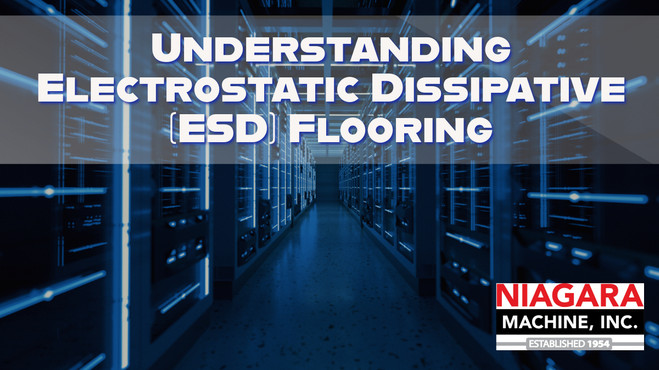Understanding Electrostatic Dissipative (ESD) Flooring
22nd Jan 2024
ESD flooring stands for electrostatic discharge flooring. It is a type of flooring that is designed to control static electricity and prevent electrostatic discharge. Electrostatic dissipative flooring is commonly used in environments where static electricity can cause damage to sensitive electronic equipment or pose a risk to people, such as in computer labs, manufacturing facilities, and cleanrooms. It typically consists of materials that have low electrical resistance, such as conductive or dissipative materials, which help to dissipate static charges and prevent the buildup of static electricity.
What is Electrostatic Dissipative (ESD) Flooring?
An ESD floor coating works by providing a conductive path for static electricity to safely discharge. It typically consists of materials that have a low electrical resistance, such as carbon or metal fibers, embedded within the flooring material. These conductive materials help to dissipate any static charges that may build up on the surface of the flooring. This prevents the accumulation of static electricity, which can be harmful to sensitive electronic equipment or cause discomfort to individuals. ESD flooring also often includes a grounding system, which further helps to redirect any static charges away from sensitive areas.
Electrostatic dissipative systems can come in various forms, including tiles, mats, or coatings, and it is often combined with other ESD control measures, such as grounding systems and ESD-safe footwear, to provide comprehensive protection against electrostatic discharge.
Benefits of ESD Flooring in Industrial and Commercial Settings
There are several advantages of ESD flooring. First, it helps to prevent damage to sensitive electronic equipment by safely dissipating static electricity. This can extend the lifespan of the equipment and reduce the need for costly repairs or replacements. Second, ESD flooring can help to create a safer working environment by reducing the risk of electrostatic discharge-related accidents, such as fires or explosions. Additionally, ESD flooring can improve the overall cleanliness of a space by minimizing the buildup of dust and other particles, which can be attracted to static charges.
ESD flooring protects equipment by preventing the buildup of static electricity and safely dissipating any static charges that may occur. When static electricity builds up on a person or object, it can discharge and potentially damage sensitive electronic equipment. ESD flooring provides a conductive path for the static electricity to safely discharge, preventing any damage to the equipment. Additionally, ESD flooring can also help to reduce the risk of electrostatic shocks to personnel, creating a safer working environment.
Choosing the Right ESD Flooring Solution
When choosing an ESD floor coating, there are a few factors to consider. First, you'll want to determine the specific requirements of your environment, such as the level of static control needed and any specific industry standards that must be met. Additionally, you'll want to consider the durability and lifespan of the coating, as well as its resistance to chemicals, abrasion, and UV exposure. It's also important to consider the installation process and any maintenance requirements. Consulting with a professional or specialist in ESD flooring can help ensure you choose the right system for your needs.
ESD flooring is commonly used in industries that deal with sensitive electronic equipment and components. Some examples include electronics manufacturing, telecommunications, aerospace, medical device manufacturing, and data centers. These industries require ESD flooring to protect their equipment from static electricity and prevent damage or malfunction.
Installation and Maintenance of ESD Flooring
ESD flooring is typically installed by professionals who specialize in this type of flooring. The installation process may vary depending on the specific type of ESD flooring being used, but generally, it involves preparing the subfloor, applying adhesive or conductive underlayment, and then installing the ESD flooring material. The flooring may need to be grounded to ensure proper static dissipation. It's important to follow the manufacturer's instructions and guidelines for installation to ensure the effectiveness of the ESD flooring.
The long-term benefits of ESD flooring include increased equipment lifespan, reduced maintenance costs, improved safety for personnel, and compliance with industry standards and regulations. ESD flooring helps to prevent costly damage to sensitive electronic equipment, which can extend its lifespan and reduce the need for repairs or replacements. This can result in significant cost savings over time. Additionally, ESD flooring creates a safer working environment by reducing the risk of electrostatic discharge-related accidents. It also helps companies comply with industry standards and regulations, which can be important for certain industries, such as electronics manufacturing or healthcare.
Electrostatic dissipative flooring is beneficial for any industry that deals with sensitive electronic equipment and components. This includes industries such as electronics manufacturing, telecommunications, aerospace, medical device manufacturing, and data centers. Additionally, any facility that has a high risk of electrostatic discharge, such as cleanrooms or laboratories, can benefit from using ESD flooring.
If you are in an industry that would benefit from Electrostatic dissipative flooring, take a look at Diama-ESD. DiamaPro Systems Diama-ESD System combines static control protection with outstanding abrasion resistance, and chemical and moisture infiltration. It eliminates the substantial expenditure required for epoxy, modular vinyl tile, carpet, or rubber flooring.
For more information on ESD floor coating or ESD epoxy coatings, give Niagara Machine a call today to speak with a coating specialist!

